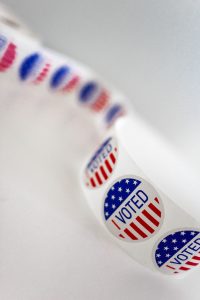How Social Media Platforms Have Impacted the Upcoming Election
Published on October 2, 2020, at 6:11 p.m.
by Emily Safron
As the United States gears up for one of the most critical elections in the nation’s history, social media has become essential in keeping up with the news. While there are many benefits to living in a heavily technology-based world, false information can spread like a wildfire. Many popular social media platforms have been working to inform and encourage users to take the election seriously.
Statistics have proven that emotions can serve as a large indicator, especially when voting. “With the diminishment of arguments which appeal to reason or logic — that is, “logos” in our country — people seem to now rely on emotion,” said Jennifer Neubauer, chairwoman of the Lake County Republican Central Committee. “One need not be an expert in any topic to uncover the holes in another person’s assertion of truth, but people seem increasingly unable to use logic to do just that.”
Voting Information Center
Instagram and Facebook have unveiled a new online hub titled the “Voting Information Center” with the hope of helping users access pertinent information regarding the election.
Upon clicking the link at the top of Instagram and Facebook’s landing pages, users can sign up to register to vote as well as view the requirements of mail-in voting in the state in which they reside. At the bottom, there are additional facts and opportunities to get users even more interested.
Additionally, on Facebook’s VIC, users have the opportunity to read posts from election officials in their designated voting area.

Fact-checking
Platforms such as Facebook and Twitter have quickly worked on initiatives to stop the spread of misinformation to readers.
Dianne Bragg, associate professor at The University of Alabama, shared her thoughts on the importance of “pausing before you post.”
“People who are educated on social media often don’t think about how those who are not will use it. It’s important to do research such as a survey or focus group in order to see how people will react to certain messaging,” Bragg advised. “You have people who are not going to verify or check out where something comes from.”
Facebook has committed to reducing the spread of false information through working with third-party fact-checkers as well as allowing users the ability to provide feedback on stories they think are inaccurate. Additionally, it has compiled a list of tips to educate users before they continue to scroll through their feeds.
The Knight Foundation has a strong focus on journalism and making sure that communities are well-informed and engaged. In 2018, it did a study that focused heavily on ‘fake news’ and the negative impact it had on the 2016 election.
“Many of the accounts active in 2016 election disinformation campaigns continue to operate, despite clear evidence of automated activity,” the report noted about the large number of bots that work to spread “fake news” on the platform.
“The more sensational and outrageous a piece of information is, the more rapidly it travels and is more likely to be shared to our social networks — reinforce our point of view,” Mark Harris, global communications advisor at Xero, shared. “These aren’t ‘stories’ reported on mainstream media, edited, fact checked or verified. They just travel via digital word of mouth. These techniques have been amplified and are much more prevalent and dangerous than they were in 2016.”
How Snapchat is targeting younger voters
A popular application for the younger crowd, Snapchat has updated its application in several ways to help its target audience of 18-to-29-year-olds get excited about registering to vote.
Partnering with TurboVote and BallotReady, Snapchat has created several resources and tools to attract younger voters, such as a way to vote directly in the app as well as a mock ballot for users to delve into their voting options. These resources can be found in a section titled “My Election Checklist” on the application’s landing page.
Snapchat has a previous history of partnering with TurboVote, noting that it successfully helped more than 450,000 Snapchatters register to vote back in 2018.
Looking ahead to November
Through several tools and resources, social media platforms are giving it their all to make sure that voters, young and old, have a clear idea of the candidates come Election Day.

“I pray that there is a generation of younger voters that will think independently and maintain an openness to what’s happening in the world,” Harris said, “rather than curating a world view that is strictly reinforcing what they already believe. If we can’t objectively evaluate credible information, then that’s a real issue for our society, and there is no question that social platforms are working against that ability to do independent thinking.”
For Bragg, “Social media has become more of a think tank. There are goals and how to get there,” she said about those she is friends with and follows on social media. “Very much so for a lot of people, just like radio stations and subscriptions, the public tends to listen to and read what they want to hear instead of going out of the box.”
Social media has changed in both negative and positive ways as the nation looks back to the past election and forward to its current election. There is still a lot of work to be done, but social media platforms are taking action and holding users accountable.




